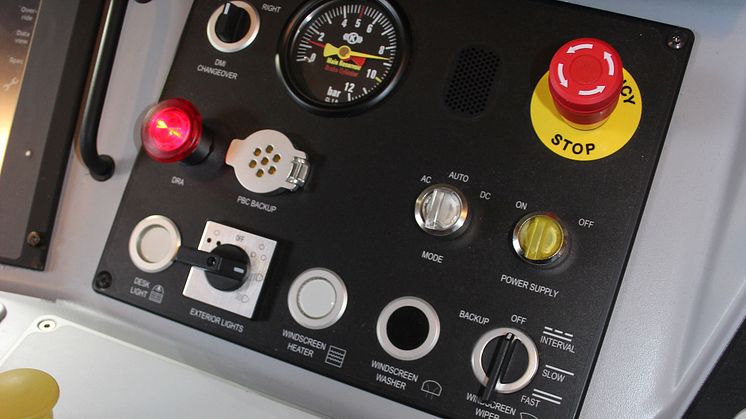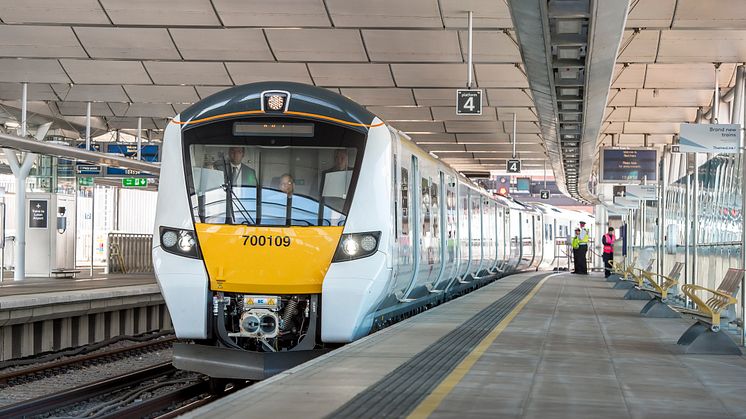
Press release -
World-first for ATO on mainline railway
Govia Thameslink Railway, working with Network Rail and Siemens, have scored a world-first by running ATO (Automatic Train Operation) over ETCS (European Train Control System) on the mainline railway in passenger service.
On Saturday, 17 March, southbound 8-car Thameslink train 700019, destination Three Bridges, brought itself to a halt automatically at London St Pancras International at 13.53 having transitioned into ETCS Level 2 Full Supervision and then ATO on its approach from Kentish Town.
With the driver checking the platforms, closing the doors and then selecting ATO again, the train with its in-cab signalling then continued under automatic control through Farringdon, City Thameslink and London Blackfriars. It finally transitioned out of the system on its exit from London Blackfriars, as it headed towards Elephant & Castle.
GTR’s Systems Integration Manager Jim Doughty, said: “This is a real world-first and I’m delighted. It is the culmination of a programme of work that that we have been involved in since the start of our franchise three years ago and which has been running continuously since the start of the £7bn Government-sponsored Thameslink Programme. It is critical to our RailPlan20/20 modernisation programme to modernise the busiest part of the UK rail network.
“Saturday’s run followed nearly two years of on-track testing and, working flawlessly, it has pathed the way for further runs. These runs will not only help build industry confidence in the system but also facilitate the commencement of the delivery of a world class training package to our drivers in readiness for the increase in services.
“This cutting-edge system will allow us to run our final high intensity Thameslink service of up to 24 trains per hour each way with 70% more seats through the centre of London, linking new communities and cutting journey times for thousands of passengers.”
Working with Network Rail and Siemens, GTR has run nearly 200 night and day shifts of testing since April 2016 when it began proving ETCS dynamically at Network Rail’s ETCS National Integration Facility at Hertford North in April 2016 and has had to demonstrate to the ORR that it has made the necessary amendments to its Health & Safety Management System to allow for the trains to operate in both ETCS & ATO in passenger service.
Saturday’s success is a milestone for the rail industry on its digital railway journey. Network Rail completely replaced the signalling in the central London Thameslink ‘core’, allowing trains to safely travel closer together, increasing capacity, and installed ETCS; Network Rail has continued to manage the systems integration for track and train. Siemens have provided the ETCS and the ATO-enabled train, the Class 700 Desiro City.
Martin Chatfield, Network Rail Project Director for High Capacity Infrastructure, said: “Seeing the first UK mainline train running in ATO for passenger services is a truly momentous day for the Thameslink Programme High Capacity Infrastructure Team, and the wider industry teams that have been involved. This underlines the combined efforts of Network Rail, the supply chain, and the train operators over the past five years to reach this point. It not only proves the digital railway technology within the heavy rail environment, but it also demonstrates that an industry approach is the way to solving railway capacity issues in the future.”
Mark Ferrer, Operations Director Digital Rail, Siemens said: “This brings to life the hard work and commitment from the entire team, including Siemens, Network Rail and GTR, proving the operation of digital signalling on a critical part of the railway infrastructure and realising the future of train control. The introduction of this technology, which was developed and delivered in the UK, maintains the UK’s position as a world leader in the application of technological solutions to the train control infrastructure, something that as an industry we aim to build on and further deploy.”
ends
Notes to editors
- Automatic train operation (ATO) will initially operate between St Pancras and Blackfriars in May 2019 (22 tph), being extended to London Bridge in December 2019
- Under ATO, the driver presses a button and the system takes over. The driver still undertakes safety checks, closes the doors and selects ATO again
- ATO uses the maximum acceleration and brake rates afforded to it which, with new signals and a new signalling system, allows us to run up to 24 trains every hour in the peak across this central section of the Thameslink route. This allows GTR to run more trains along an expanded Thameslink network, benefiting hundreds of thousands of people
- ATO works on top of a new signalling system called ETCS - or European Train Control System - which gives GTR drivers in-cab signalling and allows trains to run closer together. It overlays the existing system which can still be used as a backup
- Govia Thameslink Railway was the first Train Operator in the world to operate ATO over ETCS, with ATO testing commencing November 2016, following initial testing of ETCS, which commenced April 2016.
How this fits into GTR’s modernisation programme:
GTR is expanding the cross-London Thameslink network and simplifying timetables throughout the South East starting in May this year. This is central to our plans to modernise services. New trains, new rail routes and updated working practices will future-proof Southern, Gatwick Express, Thameslink and Great Northern where passenger numbers, in some places, have doubled in just 12 years.
Highlights of the proposed changes introduced incrementally from May 2018:
- New expanded Thameslink network to give 140 stations by programme end (80 more than today) direct access to St Pancras International, Farringdon, City Thameslink and Blackfriars in central London, all via the new station at London Bridge, relieving the Piccadilly, Victoria and Northern Tube lines
- Interchange for all 140 stations with the Elizabeth Line (Crossrail) at Farringdon from December 2018
- 70% more peak time seats between London Blackfriars and St Pancras International across central London by December 2019
- Massive increase in number of Thameslink trains at London Bridge
- New direct Thameslink routes through London between:
- Cambridge and Brighton
- Horsham and Peterborough
- Cambridge and Maidstone East (with some extensions to Ashford International)
- Luton and Kent Medway Towns (e.g. Greenwich and Dartford)
- Littlehampton and Bedford
- East Grinstead and Bedford
- Faster, seamless journeys: Cambridge to Gatwick Airport 20% faster; Greenwich to Luton Airport 37% faster; 10-15 minutes quicker to Canary Wharf and Paddington via Crossrail (Elizabeth Line) at Farringdon
- More spacious trains: 115 new Thameslink trains, many the size of 21 double decker buses.


